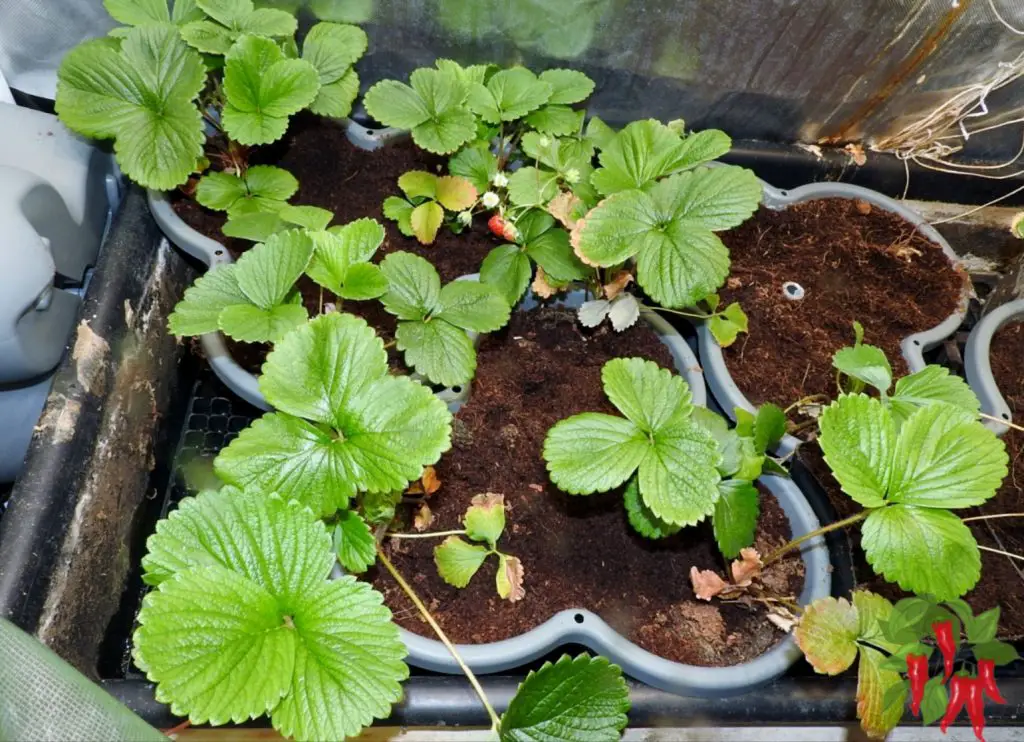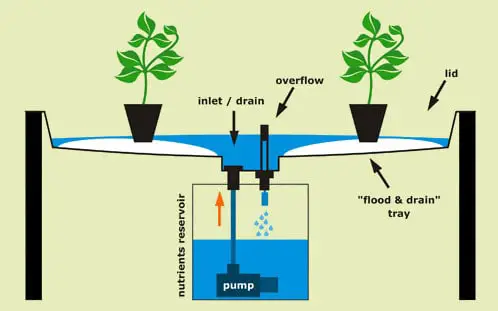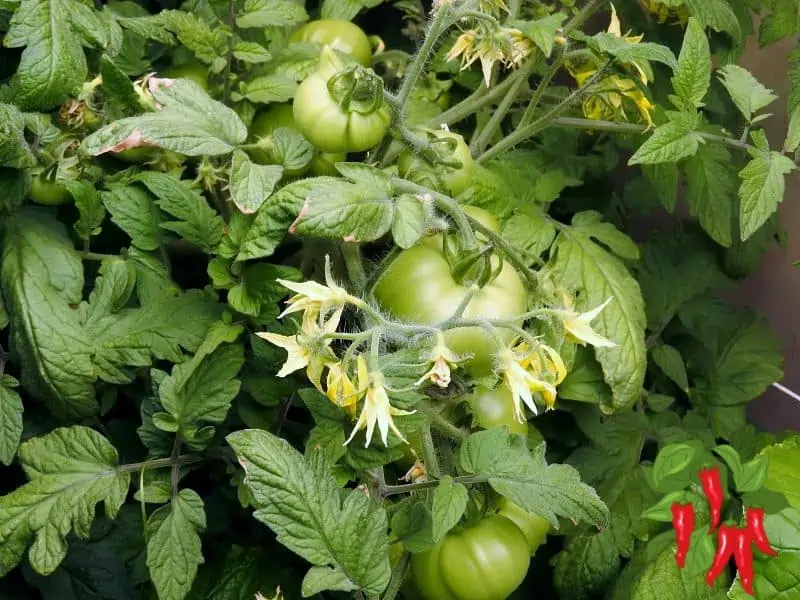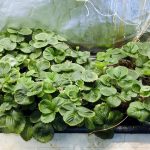This post may contain affiliate links. If you buy something from one of our links we may earn a commission. Thanks

Are you ready to dive into the world of growing hydroponic strawberries? This exciting gardening adventure allows you to harvest sweet, juicy strawberries right from your living room or any indoor setup.
Growing Hydroponic Strawberries
Key Takeaways:
- Growing hydroponic strawberries offers a soil-free solution to garden indoors, allowing for year-round production.
- Ideal for limited spaces, this method enhances control over environmental factors
- It leads to potentially higher yields and fewer pests than traditional gardening.
How To Grow Hydroponic Strawberries
Howdy everyone. Today, we’re going to talk about how to grow hydroponic strawberries. I am in my grow tent under an LED light.
Forget about soil and the usual garden pests; let’s explore how these vibrant red treasures can thrive in a hydroponic environment, bringing a burst of flavor and color to your home all year round!
Strawberry Plants for Hydroponics
Seascape Strawberry Plants – Bare Root Plants
Okay, so first things first, we need to talk about what type of strawberries you should grow.
These are Seascape strawberries. You can see there’s a tiny berry on one plant that I missed picking off.
These plants are not up to snuff yet, but you want to use a day-neutral variety. That’s one that will bear fruit all season long. I am growing Seascape strawberries.
You don’t want to plant a June bearing variety because you’ll only get one crop. So when you’re doing, hydroponics, you’re after an extended harvest. So these are Seascape strawberries.
Like I said, I’ve done some research. They say it’s one of the best varieties there is. So, you know, you can try them. There are others like Albion and Evie. Just make sure it’s a day neutral variety and you should be good.
Growing Hydroponic Strawberries
If these pots in the video look familiar to you, it’s because I had to take down that five-tier planter I had.
You know, sometimes when you grow indoors, you have to learn how to pivot when something’s not working.
The strawberry tower, although it’s a great idea, and it would work outdoors pretty well, did not work out for me indoors.
I Rescued the Plants to my Flood and Drain System
If you take a look at the plants on this end, you can see they’re leggy, and they were not getting enough light, and actually some of them didn’t even make it.
What happened was I raised my light. Because I have a dwarf citrus tree in there I wanted to spread the light out but the tower was not getting enough light.
Even though it was right under the light, and only a few feet away, the bottom was too far, and also, they were crowded in with other plants, and what I found, is that the light just did not penetrate down to the bottom.
So I decided to move the strawberry plants containers and all into my tried and true ebb and flow system inside my 4×2 foot grow tent instead.
One tier wouldn’t fit so I also have a couple of plants in 4 1/2 pots.
Hydroponic Strawberries Grow Time
Some folks say it takes 90 to 120 days for strawberries to produce fruit. I disagree.
My Seascape plants started flowering a few weeks after transplanting. However, I picked off most of the flowers to allow the plants to grow and develop without having to ripen fruit.
I would recommend allowing plants to grow 5-8 weeks before allowing them to set fruit.
Although strawberries are self-fertile hand pollination will increase production and eliminate misshapen berries that result from incomplete pollination.
Best Hydroponic System for Strawberries
I think flood and drain also called ebb and flow is the best hydroponic system for strawberries. It’s easy to set up and beginner-friendly.
It’s a versatile hydroponic system allowing the growth of many different plants and vegetables.
So I got my lavender out of this closet and I decided to put these in instead. So we’re going to grow them hydroponically in a flood and drain system.
This is a flood and drain system. It is a popular recirculating hydroponic system meaning it reuses the nutrients multiple times.
So there’s a reservoir underneath, and then there’s a pump, and the water pumps into the tray, and then when it’s done, it drains back into the reservoir.
How Flood and Drain Systems Work

So, this is a project that’s not that hard to set up. I think you can see and you get the gist of it from the video.
- These strawberry plants are in a tray, and the tray has two fittings in it.
- One fitting fills the tray and the other one drains it.
- The tray fills up with water from the pump, and then the water drains back into the reservoir.
- You need two trays.
- You need a tray to hold your plants in and a tray or tote to hold the nutrients and pump
Because height is limited in my grow tent, I use a 20-gallon mixing tote that I got from Home Depot. It’s rated at 20 gallons and it’s only about eight inches high, so I use that.
I have some boards across the top of the reservoir that keep the upper tray raised and I have a cover to keep the light out of the reservoir.
Now you could use any size tote, and you could use a different sized tray that’s raised above it. This is just the way I set this up, but the basics are the same.
You need a reservoir underneath your tray. You need a tray up on top and it needs to be able to drain back into your reservoir.
So as long as you meet those requirements, you’re good to go. There’s no specific size tray that you need.
Use what you have. I could have used two of the bottom trays but this top tray allows me to get a little bit more space in.
I bought it on Amazon, but I don’t believe it’s available anymore. But you can customize it like this.
They also sell flood trays. You could buy a two-by-four tray or even a four-by-eight tray if you wanted to. You just need to be able to have a place to fit it.
The flood and drain system is a great setup. You can grow strawberries. You can grow just about anything in here.
It’s beginner friendly. The only thing you have to do is get your watering cycle down. Like I said, for coco, I would maybe water twice a day.
If you’re using grow stones, perlite, or LECA, you probably want to run your pump every two or three hours, because those don’t hold a lot of moisture.
Read more: Hydroponic Gardening At Home: Easy Gardens Without Soil
Best Growing Medium for Hydroponic Strawberries
I just want to mention these are in coco coir. Coco coir is a hydroponic grow medium and it may look like soil, but it is not.
It is an inert medium which means it does not provide any nutrients on its own. So you must feed plants growing in coco.
You also do not want to let coco dry out. It should always be moist and should always be watered with nutrient solution and never plain water.
So, it’s a good grow medium for this system. It’s pretty easy to set up, and it works really well.
You could use a more traditional hydroponic grow medium. You could use perlite or grow stones or LECA pebbles (hydroton), but I use coco and it works well and it does not need to be watered as much.
If you’re using a LECA, for example, you’d probably have to water it every couple of hours in order to keep it wet.
But with coco coir watering once or twice a day, it holds enough moisture and you’re getting the soil moist, but you’re not getting it soggy.
I think these plants are going to really take off once, they grab hold in here. Actually, this is the first 24-hour period they’ve been in here.
Read more: Hydroponic Grow Medium: 5 Easy Tips For Beginers
Strawberry Hydroponic Nutrients
So, down below is my reservoir and in the video I think you can see there are some bubbles. I do have a little air pump in there.
It kind of helps keep everything stirred up and aerated. It’s optional, but I think it’s a good idea.
Milwaukee MW802 LED Economy Portable pH/EC/TDS Meter
And also, I have my Milwaukee meter to test the nutrient solution. So we are looking at 820 parts per million and a pH of 6. 1.
I recommend getting a cheap TDS pen and a PH pen if you’re going to use hydroponics because you want to know what strength you’re mixing your nutrients at.
Also maintaining the right pH makes sure that your nutrients are available to your plants.
If your pH gets too far out of whack you could experience nutrient lock out.
You can also get this combination hand meter, but it’s expensive and It costs a couple of hundred bucks.
You can buy pens for less although they may not be as accurate or last as long but they are still better than using nothing at all.
Find cheaper options on Amazon
My Hydroponic Strawberry Nutrient Formula
Jack’s Classic Nutrients Part A Formula, 5-12-26 Water-Soluble Fertilizer, 2.2lbs
Now, as for nutrients, I use a mix called Jack’s 3 2 1. It’s a three part mix. It has a base hydroponic mix, it has calcium nitrate, and then it also has Epsom salts for magnesium.
You mix them together in that ratio, three parts of the base, two parts of the calcium nitrate, and one part of the magnesium sulfate
It’s an inexpensive mix, it works really well, and it has all the trace elements in it that your plants will need, and all that good stuff.
And it’s used by a lot of commercial greenhouses. So, I recommend it, but you could use any nutrients you want. You just want to make sure they’re for hydroponics.
As to these plants, I think we’re going to see some pretty awesome growth from them. Especially from these on the side that didn’t get enough light. There’s a few plants that didn’t make it and I replanted them.
But I’m looking forward to a nice crop of strawberries in here.
Read more: Are Hydroponic Nutrients Required? 7 Easy Tips For Beginners
My Flood and Drain System Runs On Autopilot
One of the things about this hydroponic system that’s neat is it’s all automated. My pump’s on a little timer and my lights are on a time too. I run 12 hours on, and 12 hours off. That’s about all the light they need.
I have a temperature and humidity sensor here. It’s 79 degrees, 44 percent humidity right now with the tent open.
LED Grow Lights
You are going to need a good full spectrum LED grow light. I am using an old COB it’s an old school LED. And it’s rated at 250 watts. I don’t recommend buying one if you’re going to get a light. COBs are kind of outdated.
COB stands for chips on board. And what they are is a lot of little chips on a disc. And so they’re kind of more like a spotlight.
They were really popular when people started using LEDs, But now you want to get an LED quantum board and you want to get LED lights with Samsung 301B diodes in it.
It’ll give you better coverage, and the spectrum is perfect for growing plants, it’s about 3000K.
I have a Spider Farmer SF2000 in my kitchen garden and the new model is the same price its wider and covers a 3×3, 4×4, or 5×5 area depending on price but the 3 x 3 is the same price as my older unit but covers a square area better.
They work really well. So I recommend an LED light. You put it on a timer. You run it 12 hours on, 12 hours off. They don’t use a lot of electricity, so that’s all good.
So this hydroponic system is pretty much automated. I mean, all I have to do is make sure the reservoir stays full and that’s just basically checking it a couple of times a week.
And then everything else runs on autopilot pretty much. So it’s a good setup.
Read more: LED Hydroponic Lighting: Easily Grow Plants with LED Lights
Providing Good Ventilation
I do want to mention you’re going to need ventilation if you’re using a closet or grow tent.
I have this little fan and as you can see in the video these leaves are gently moving in the breeze, which is what you want. You don’t want to beat them to death with a fan.
Also, it’s very important to use an exhaust fan to get the warm moist air out if you’re using a tent or a closet.
In an open room, you don’t need this, but inside a closet or grow tent, you’re going to need a fan to exhaust it. I use a 4-inch fan but they also come in 6 and 8-inch sizes.
AC Infinity CLOUDLINE PRO S4, Quiet 4” Inline Duct Fan with Speed Controller
I use an AC Infinity fan, and it’s adjustable. It has a built-in speed control that you can use to set the fan speed and that’s really handy to help you maintain the right temperature and humidity.
So that’s a great fan. I recommend it if you need an exhaust fan
Growing Hydroponic Strawberries Indoors Final Thoughts
As we wrap up our journey into growing hydroponic strawberries, let’s reflect on the significant advantages and some practical tips to ensure your strawberry venture is as fruitful as possible.
Key Takeaways
- Versatile Planting Options: Hydroponics allows for various setups, from simple containers to advanced systems, fitting any indoor space.
- Controlled Environment: Manage light, nutrients, and water more efficiently, maximizing strawberry growth and health.
- Extended Growing Season: Enjoy strawberries throughout the year, free from the constraints of traditional outdoor gardening.
- Higher Yields: Optimized conditions can lead to more abundant and consistent strawberry production.
- Pest Management: Reduced pest issues thanks to the indoor, soil-free environment.
- Automation Potential: Automate critical aspects like watering and lighting for easier maintenance and better growth.
As far as the strawberries go, you should get a better yield indoors than you would outside because you control the climate and you’re not dealing with pests, bugs or mold or anything like that.
And typically, plants do grow and yield faster in hydroponics.
Now, I’m not going to say for sure that you’ll get a higher yield, but typically you do.
I do want to mention that the nutrient solution is at about 800 parts per million on my meter and ideally, you’d be a little bit higher, but these are just starting out.
I never seem to have to go above 1, 000 to 1, 200 parts per million, so use that as a guideline.
The pH right now is 6. 2, and that’s fine. The ideal is about 5. 8, but you can go up to 6. 5 and it’ll work.
I want to mention that less is more when it comes to fertilizing plants. Dont over fertilize it can kill or damage your plants.
I will come back and update you when these things are starting to really grow. So take good care of yourselves. Happy gardening.
Don’t forget, keep it green. Alright, bye-bye.
Visit my Amazon Influencer Page for videos and gardening products Grow Your Own Garden











